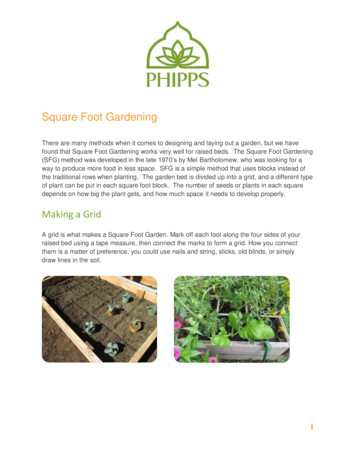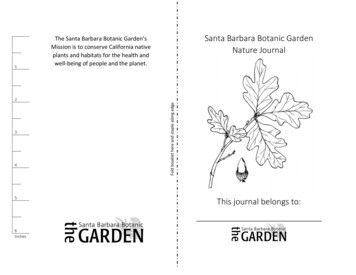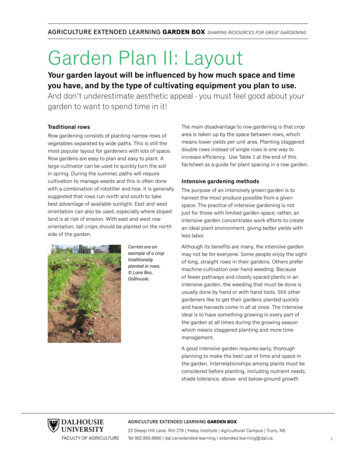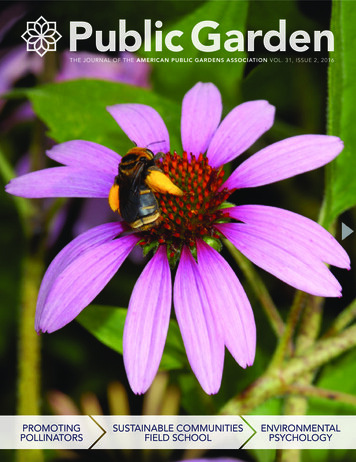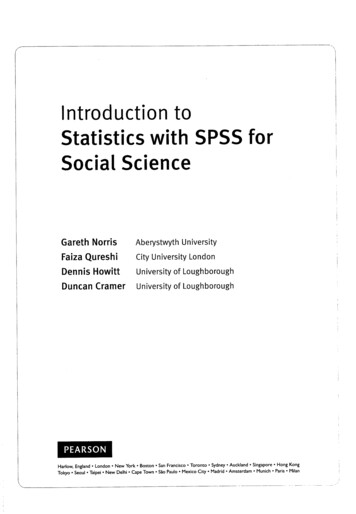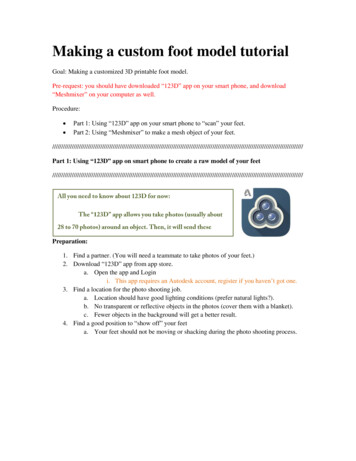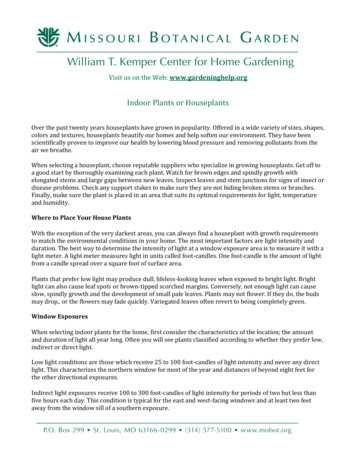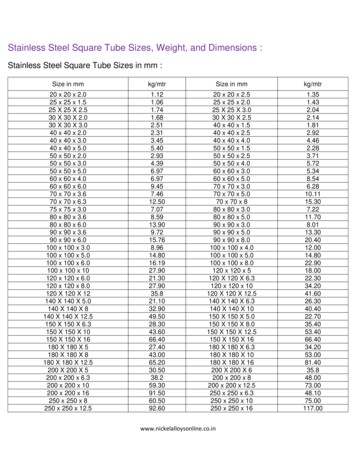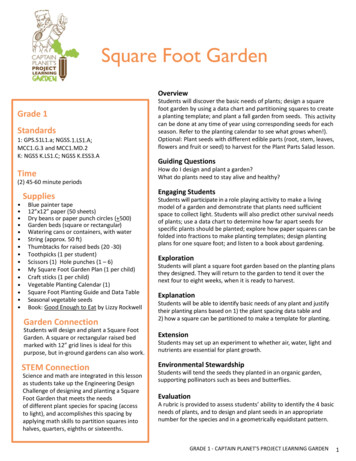
Transcription
Square Foot GardenOverviewGrade 1Standards1: GPS.S1L1.a; NGSS.1.LS1.A;MCC1.G.3 and MCC1.MD.2K: NGSS K.LS1.C; NGSS K.ESS3.ATime(2) 45-60 minute periodsSupplies Blue painter tape12”x12” paper (50 sheets)Dry beans or paper punch circles ( 500)Garden beds (square or rectangular)Watering cans or containers, with waterString (approx. 50 ft)Thumbtacks for raised beds (20 -30)Toothpicks (1 per student)Scissors (1) Hole punches (1 – 6)My Square Foot Garden Plan (1 per child)Craft sticks (1 per child)Vegetable Planting Calendar (1)Square Foot Planting Guide and Data TableSeasonal vegetable seedsBook: Good Enough to Eat by Lizzy RockwellGarden ConnectionStudents will design and plant a Square FootGarden. A square or rectangular raised bedmarked with 12” grid lines is ideal for thispurpose, but in-ground gardens can also work.STEM ConnectionScience and math are integrated in this lessonas students take up the Engineering DesignChallenge of designing and planting a SquareFoot Garden that meets the needsof different plant species for spacing (accessto light), and accomplishes this spacing byapplying math skills to partition squares intohalves, quarters, eighths or sixteenths.Students will discover the basic needs of plants; design a squarefoot garden by using a data chart and partitioning squares to createa planting template; and plant a fall garden from seeds. This activitycan be done at any time of year using corresponding seeds for eachseason. Refer to the planting calendar to see what grows when!).Optional: Plant seeds with different edible parts (root, stem, leaves,flowers and fruit or seed) to harvest for the Plant Parts Salad lesson.Guiding QuestionsHow do I design and plant a garden?What do plants need to stay alive and healthy?Engaging StudentsStudents will participate in a role playing activity to make a livingmodel of a garden and demonstrate that plants need sufficientspace to collect light. Students will also predict other survival needsof plants; use a data chart to determine how far apart seeds forspecific plants should be planted; explore how paper squares can befolded into fractions to make planting templates; design plantingplans for one square foot; and listen to a book about gardening.ExplorationStudents will plant a square foot garden based on the planting plansthey designed. They will return to the garden to tend it over thenext four to eight weeks, when it is ready to harvest.ExplanationStudents will be able to identify basic needs of any plant and justifytheir planting plans based on 1) the plant spacing data table and2) how a square can be partitioned to make a template for planting.ExtensionStudents may set up an experiment to whether air, water, light andnutrients are essential for plant growth.Environmental StewardshipStudents will tend the seeds they planted in an organic garden,supporting pollinators such as bees and butterflies.EvaluationA rubric is provided to assess students’ ability to identify the 4 basicneeds of plants, and to design and plant seeds in an appropriatenumber for the species and in a geometrically equidistant pattern.GRADE 1 - CAPTAIN PLANET'S PROJECT LEARNING GARDEN1
StandardsGeorgia Performance Standards in Science (first grade)S1L1. Students will investigate the characteristics and basic needs of plants . . . .a. Identify the basic needs of a plant.1. Air2. Water3. Light4. NutrientsNext Generation Science Standards (kindergarten)NGSS K.LS1.C Organization of Matter and Energy Flow in OrganismsPlants need water and light to live and grow. (K-LS1-1)NGSS K.ESS3.A: Natural Resources (kindergarten)Living things need water, air, and resources from the land, and they live in places that have the things they need. Humansuse natural resources for everything they do. (K-ESS3-1)NGSS 1.LS1.A Structure and Function (first grade)1. Plants also have different parts (roots, stems, leaves, flowers, fruits) that help them survive and grow. (1-LS1-1)Georgia Performance Standards in Common Core Math (first grade)MCC1.G Understanding Shapes and Fractions (first grade)MCC1.G.3 Partition circles and rectangles into two and four equal shares, describe the shares using thewords halves, fourths, and quarters, and use the phrases half of, fourth of, and quarter of. Describe thewhole as two of, or four of the shares. Understand for these examples that decomposing into moreequal shares creates smaller shares.MCC1.MD Measure Units Indirectly and by Iterating Length Units (first grade)MCC1.MD.2 Express the length of an object as a whole number of length units, by laying multiple copies of a shorter object(the length unit) end to end; understand that the length measurement of an object is the number of same-size length unitsthat span it with no gaps or overlaps. Limit to contexts where the object being measured is spanned by a whole number oflength units with no gaps or overlaps.Background InformationRecommended gardening books to read with students:Water, Weed and Wait by Edith Hope Fine & Angela Demos HalpinThe Dandelion Seed by Joseph AnthonyIn a Nutshell by Joseph AnthonyFor more about square foot gardens expanding biodiversity, making crop rotation easy, reducing water needs, supportingpollinators, and increasing productivity of organic gardens: ore these excellent resources for details on square foot gardening:How to Plant a Square Foot plant-a-square-foot-gardenSquare Foot Garden Spacing ng/Square Foot Garden Planting Guide (illustrated table with plants and spacing ting-guideSquare Foot Gardening Data Table and Planting Season Chart in -apart Square Foot Gardening Chart for Planning Entire Garden dPlate-SFG-planner.pdfBook: Square Foot Gardening with Kids by Mel BartholomewGRADE 1 - CAPTAIN PLANET'S PROJECT LEARNING GARDEN2
Teacher Preparation Obtain all needed supplies and materials, including seeds appropriate for the season.Refer to the Vegetable Planting Calendar below to decide which seeds students may choose from, based on the season.Consider planting seeds for fruits, vegetables and greens the class can harvest in 4 – 8 weeks for the Plant Parts Saladlesson. This would include plants with various edible parts, i.e. root, stem, flower, fruit, seed, and leaf.Make copies of the following materials for each child:o Square Foot Planting Guide (chart or table that shows number of seeds per square, for various plants) Alternatively, show this chart with an lcd projector so all can see, instead of making copieso My Square Foot Planting Plan (included below)Cut apart this Square Foot Garden Planner Chart into individual squares, for an extension math activity, if andPlate-SFG-planner.pdfPROCEDURES FOR LESSON ACTIVITIESDay 1: In the ClassroomEngagement (15- 20 min)Square Foot Garden Role Play Introduce the idea that students will be designing and planting a square foot garden, where a different type of plant isgrown in each square. Read a book to the class about gardening. Mark off a 5 ft x 5 ft square on the floor of the classroom with blue painter tape (or a smaller square for fewer kids)and tell students this represents one square in a square foot garden. Invite several students at a time to come to the taped square and join other students playing the part of seeds bysquatting in the square, until the entire class is squished together with at least one foot inside the square. When theteacher says, “Grow!” students should pretend to grow and bloom, standing up with their arms out and palms up, likeleaves trying to capture light. There will be lots of hands in people’s faces and general discomfort. Next, tell students they may step out of the square to stand one arm’s length from each other and squat down to playthe role of seeds again. When the teacher says “Grow!” students should pretend to grow and bloom, standing againwith arms out and palms up, like leaves trying to capture light. Ask students whether they would get more sunlight on their leaves if they grew close together or spread out? (Acceptstudent answers and agree that plants need sunlight to make food inside their leaves. When plants are crowdedtogether, some of the leaves cannot get sun because they are shaded by other plants). Important point: Just like animals, some types of plants grow up to be big and other types grow up to be tiny. The sizeof the plant is one way to decide how much space it needs in the garden, so it can get enough sunlight to grow. In thesquare foot garden, a plant that will grow up to be big will need the whole square for itself. However, several smallerplants may fit into one square foot. Ask students to freeze in place and imagine that their legs are stems that cannot move. Students should pretend theyare stuck standing where they are now, forever! Ask what would they need to survive? (Accept and record allanswers. Then distinguish between wants and needs. Needs Light, air, nutrients and water) Important point: Plants make their own food inside their leaves, using sunlight and air. However in addition to thefood they make, plants also need nutrients – vitamins and minerals usually obtained from soil - to be healthy.Still Day 1: In the ClassroomExploration Engineering Design Challenge Preparation: Folding a Square to Partition into 1/2s, 1/4s, 1/8s, and 1/16s (15- 20 min)Provide each student with a sheet of 12 x 12 paper and approximately 16 dry beans (or paper punch circles). Haveextra sheets of paper available for children who need to start over.Project a Square Foot Planting Guide on a screen OR provide copies for students. Show students how the data tableprovides information about the names of plants and the number of seeds for each type of plant that can be planted inone square. (The number of seeds is based on the size of the plant when it is fully grown: not the size of the seed).Pick a plant for which two seeds should be planted in one square foot and point it out on the data table. Tell studentsthey will be pretending to plant these 2 seeds an equal distance apart, so they have enough space to collect sunlight.Challenge students to fold the paper any way that makes two equal halves, so the paper can be used as a template(model) for planting 2 seeds, when unfolded. Horizontal, vertical or even diagonal folds are acceptable solutions, aslong as the square is divided into two equal parts. Students may place a bean or other marker on each half of thepaper to show how they would plant two seeds in a square foot garden.Ask students to find a plant on the data table for which 4 seeds are recommended per square and point it out. Readthe plant’s name and ask students how they could fold the same piece of paper into four equal parts. Students shouldGRADE 1 - CAPTAIN PLANET'S PROJECT LEARNING GARDEN3
discover that they can divide the square into quarters by folding it in half twice. Students may place a bean in themiddle of each of the four quarters of the square, to show how they would space apart and plant four seeds.Ask students to predict how many parts there would be if they folded the paper in half three times. Let students makethe folds and compare results to predictions; then find plants in the data table for which 8 seeds should be plantedand use beans to show how the those seeds would be spaced and planted in the square.Repeat the process, with students predicting and then checking to see how many parts would be created with fourfolds; and placing a bean in each of the sixteen squares.Ask students if they can find a way to fold the paper into nine equal parts. (There are at least two possible solutionsfor planting 9 seeds equidistantly: the paper can be folded in thirds horizontally and then in thirds vertically, to createnine equal squares, and a seed planted in the middle of each. Alternatively, the paper can be folded in half four timesto create 16 equal squares and a seed can be planted at all nine intersections of horizontal and vertical fold lines).Engineering Design Challenge: Planning to Plant a Square Foot Garden (15-20 minutes)Divide students into pairs for the engineering design challenge. (Papers must still be completed individually).Give each student a copy of fresh 12x12 paper, recycling the old.Let each pair of students choose a type of plant from among those the teacher has available. Students should find theplant on the Square Foot Garden Planting Guide and determine how many seeds can be planted in a square foot; thendivide 12x12 paper into an appropriate number of equal parts and show where seeds go, by placing peas on paper.After the teacher checks and confirms the location and number of seeds for the species, students will be allowed touse a hole punch to make a hole in the middle of each part of their folded papers. When opened and placed on top ofthe garden soil, the paper will serve as a template for planting seeds by pushing them through the holes.After punching the holes, each student should complete the My Square Foot Garden Plan worksheet.Let student choose from among plants preselected by the teacher. Continue to display the Square Foot Garden GuideLaminate students’ Square Foot Garden Plans and glue or staple to craft sticks, for use as plant markers.Day 2: In the GardenEnvironmental StewardshipEngineering Design Challenge: Planting a Square Foot Garden (30 minutes) In advance: Use thumbtacks to pin pieces of string across raised bed(s) and make a grid of 12” by 12” squares. Explain garden work and behavior expectations to students before going outside (e.g. staying with partners,keeping within assigned boundaries, listening quietly for directions). Things to take outside include seeds, laminated plant markers (aka students’ My Square Foot Garden Plan”worksheets attached to craft sticks), string, scissors, thumbtacks, toothpicks, seeds for selected plants andwatering can with water. Each pair of students should bring one of their 12” x 12” seed planting templates. Let students assist in arranging the Square Foot Garden. One at a time, each set of partners should place theirseed template within the grid on top of the soil, pinning it in place with toothpicks. For best results, rearrangeto locate all the tall or climbing plants along the north edge of the garden. Pass out seeds to each pair of students, based on their Square Foot Garden Plans. Partners will push seeds inthe holes and into the soil beneath their templates; then pick up the templates and cover seeds with soil. Continue to bring the class back to the garden over the next six to eight weeks to tend their plants. Discuss thevalue of the garden to pollinators and let students take and display pictures of the pollinators who visit.ExplanationAsk students whether the newly planted seeds are getting their basic needs met? Have watering cans ready and allowstudents to water. Discuss with students how healthy plants contribute to the health of people who eat them.EvaluationA rubric is attached to assist in assessing student demonstration of proficiency in meeting the basic needs of plants.ExtensionChallenge students to make use of leftover seeds and space in the garden bed to set up an experiment that is a “fair test”of whether a presumed basic need of a plant is actually essential to its survival. Students may plant seeds in test plots andinvestigate one variable at a time, such as whether sunlight is essential to plants. Encourage the class to brainstorm waysto carry out the investigation so that a test plant can be compared to a control plant that is treated exactly the same way–except for one variable (such as covering the test plant or planting too many seeds in one square). Consider whether theexperiment may cause unintended consequences (confounding variables) such as increasing heat beneath the cloth.GRADE 1 - CAPTAIN PLANET'S PROJECT LEARNING GARDEN4
My Square Foot GardenMy Square Foot GardenName:Name:The type of seed I will plant in my garden square is:The type of seed I will plant in my garden square is:For this type of plant, the number of seeds ofthat have room to grow in a square foot isFor this type of plant, the number of seeds ofthat have room to grow in a square foot isMy drawing shows the number of seeds Iwill plant and how I will space the seedsequally apart, by marking an X for each seed.My drawing shows the number of seeds Iwill plant and how I will space the seedsequally apart, by marking an X for each seed.GRADE 1 - CAPTAIN PLANET'S PROJECT LEARNING GARDEN5
Courtesy of Refreshing the Home and WarrDudeGRADE 1 - CAPTAIN PLANET'S PROJECT LEARNING GARDEN6
Vegetable Planting Calendar for Atlanta AreaGRADE 1 - CAPTAIN PLANET'S PROJECT LEARNING GARDEN7
Planting Calendar DefinitionGRADE 1 - CAPTAIN PLANET'S PROJECT LEARNING GARDEN8
Assessment for Square Foot Fall GardenStudent Name:Date:Level of MasteryBenchmark orPerformance MeasureEMERGINGNot yet proficient1 pointCOMPETENTPartially proficient4 pointsPROFICIENTMastered task5 pointsStudent names 0 or 1of the 4 needs ofplants in the garden.Student names 2 or 3of the 4 needs ofplants in the garden.Student names the 4basic needs of plants inthe garden:Air, water, light,nutrients.Student can partition asquare into halves,quarters, or smallerfractions to create atemplate for correct seedspacing.Student candemonstrate folding asquare once to divideit in half.Student candemonstrate folding asquare in once todivide it in half, andfolding it again todivide it in fourths(quarters).Student can divide asquare into two, four,or eight equal parts.(When given a papersquare, studentdemonstrates folding inhalf multiple times toget smaller parts).Student can make aplanting plan that isappropriate for the plantselected, in a square footgarden.Planting plan isattempted but ismissing informationabout type of plant,number of seeds, ordrawing that showsseed spacing.Planting planidentifies name /ornumber of seeds forthat species correctly,but drawing of seedspacing is not corrector does not matchtext (or vice versa).Students do not spacetheir seeds correctlyin their paper squarefoot or in the gardenStudents space theirseeds correctly ineither the papersquare or the gardenPlanting plan identifiesname of plant andcorrect number ofseeds for that speciesin one square foot;drawing shows correctnumber of seedsspaced approximatelyequidistant.Seeds are correctlyplanted for the species,according to spacingchart.Student can identify thefour basic needs ofplants.(Clarification: space is notconsidered a basic need of aplant but give credit if studentcan explain that space orcrowding determines whether aplant gets enough sunlight).(Clarification: student does notneed to represent plant indrawing of planting plan. Seedsmay be represented by anymark)Student can work in apair or a team to plant asquare foot garden.GRADE 1 - CAPTAIN PLANET'S PROJECT LEARNING GARDENTOTALPOINTS9
model of a garden and demonstrate that plants need sufficient space to collect light. Students will also predict other survival needs of plants; use a data chart to determine how far apart seeds for specific plants should be planted; explore how paper squares can be folded into fractions to make planting templates; design planting

